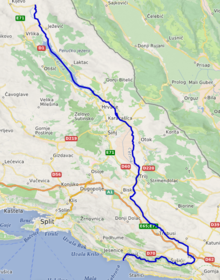Cetina
| Cetina | |
|---|---|
 Cetina flows through rocky, karst terrain. | |
 | |
| Location | |
| Country | Croatia |
| Physical characteristics | |
| Source | |
| • location | Dinara |
| Mouth | |
• location | Adriatic Sea |
• coordinates | 43°26′23″N 16°41′11″E / 43.4398°N 16.6864°E |
| Length | 101 km (63 mi)[1] |
| Basin size | 1,463 km2 (565 sq mi)[1] |
Cetina (pronounced [tsětina]) is a river in southern Croatia. It has a length of 101 km (63 mi) and its basin covers an area of 1,463 km2 (565 sq mi).[1] From its source, Cetina descends from an elevation of 385 metres (1,263 ft) above sea level to the Adriatic Sea. It is the most water-rich river in Dalmatia.[2]
Geography and geology
Cetina has its source in the northwestern slopes of
Apart from its visible basin, the Cetina also receives a lot of water from the west Bosnian karst field via underground routes. Its lower course begins from the Gubavica Falls, at 49 metres (161 ft) above sea level, near the village of Zadvarje, 20 kilometres (12 mi) from Omiš. Here it leaves its canyon and flows into a valley which has nevertheless retained something of the appearance of a canyon.[2]
The latter portion of Cetina and its relatively large drop in elevation was used to build several substantial
The total drainage area of the catchment is around 12,000 km2, and the annual discharge is around 105 m3s−1 as a consequence of a mean annual rainfall of 1380 mm.[3]
Bounded to the east by the
History and archaeology
The Cetina Valley and the narrow passage at Klis have always functioned as a principal trade route between the Croatian coast and hinterland. Strategically, it has been pivotal to the development, not only of the Balkans, but also of significant parts of Europe.[3] The earliest evidence for agricultural activity is from the Early
The area is intimately associated with the heartland of the
During the early
During later periods the area was highly contested and passed between a number of regional and local powers before conquest by the Ottoman Empire during the early 16th century. After this it retained a frontier role between Ottoman Empire and Republic of Venice until the reconquest of the area 150 years later.[3]
Today canyon of the river Cetina is very popular among tourists looking for adventure activities like rafting, canyoning, zip-line, rock climbing, kayaking and other outdoor activities.
References
- ^ ISSN 1333-3305. Archived from the original(PDF) on 13 November 2018. Retrieved 23 May 2018.
- ^ ISBN 953-178-097-8
- ^ S2CID 58925017.
- ^ Mrla, Domagoj (2019-09-25). Analiza rada termoelektrane i hidroelektrane na Peruči (bachelor thesis) (in Croatian). University of Zagreb. Faculty of Mechanical Engineering and Naval Architecture. pp. 14–22.

